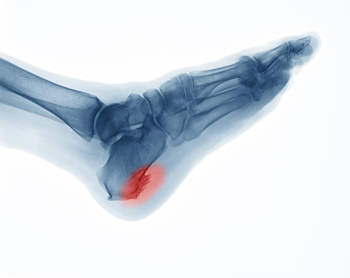(517) 487-5171
Fax (517) 908-0172
What Are Heel Spurs and How Do They Form?
Tuesday, 03 May 2022 00:00
Heel spurs, also referred to as calcaneal spurs or osteophytes, are calcium deposits that develop on the heel bone over time. They typically form in response to chronic strain or tears to the plantar fascia tissue that connects the heel with the toes, or to damage to the heel bone membrane. Other factors that may contribute to heel spurs developing include obesity, wearing improper shoes, age, trauma, training on hard surfaces, or having plantar fasciitis (damage to the plantar fascia) or certain medical conditions. Heel spurs develop on the part of the heel that is closest to the arch, and they point towards the middle of the foot. Heel spurs can be up to a half inch long and are usually only detectable with an X-ray. Heel spurs are usually not painful. When they are, a podiatrist can treat them with rest, ice, orthotic devices and/or shoes, anti-inflammatory medication, cortisone injections, or even surgery if necessary (to remove the spurs).
Heel spurs can be incredibly painful and sometimes may make you unable to participate in physical activities. To get medical care for your heel spurs, contact Dr. Gary Cesar from Michigan Foot and Ankle Center. Our doctor will do everything possible to treat your condition.
Heels Spurs
Heel spurs are formed by calcium deposits on the back of the foot where the heel is. This can also be caused by small fragments of bone breaking off one section of the foot, attaching onto the back of the foot. Heel spurs can also be bone growth on the back of the foot and may grow in the direction of the arch of the foot.
Older individuals usually suffer from heel spurs and pain sometimes intensifies with age. One of the main condition's spurs are related to is plantar fasciitis.
Pain
The pain associated with spurs is often because of weight placed on the feet. When someone is walking, their entire weight is concentrated on the feet. Bone spurs then have the tendency to affect other bones and tissues around the foot. As the pain continues, the feet will become tender and sensitive over time.
Treatments
There are many ways to treat heel spurs. If one is suffering from heel spurs in conjunction with pain, there are several methods for healing. Medication, surgery, and herbal care are some options.
If you have any questions feel free to contact our offices located in Lansing and Mt. Pleasant, MI . We offer the latest in diagnostic and treatment technology to meet your needs.








